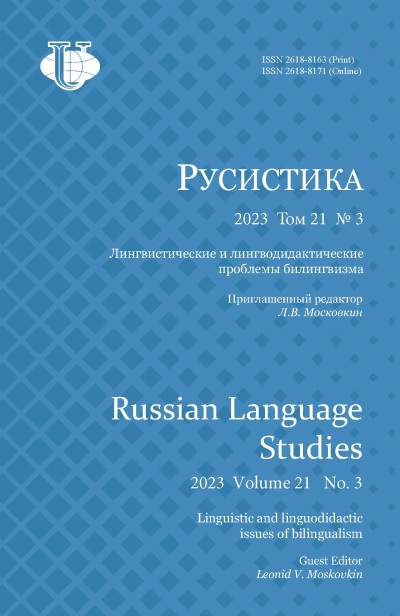Comprehensive diagnostics of the level of Russian language proficiency in a multiethnic Russian school
- Authors: Khamraeva E.A.1, Kytina N.I.2, Bolmazova E.V.3
-
Affiliations:
- Moscow Pedagogical State University
- Information and Methodological Center
- Department of Education of the Domodedovo City District Administration
- Issue: Vol 21, No 3 (2023): Linguistic and linguodidactic issues of bilingualism
- Pages: 370-386
- Section: Methods of Teaching Russian as a Native, Non-Native, Foreign Language
- URL: https://journals.rudn.ru/russian-language-studies/article/view/36385
- DOI: https://doi.org/10.22363/2618-8163-2023-21-3-370-386
- EDN: https://elibrary.ru/TUOUEO
- ID: 36385
Cite item
Full Text
Abstract
The most important tool for the adaptation and integration of foreign-speaking children into the Russian educational space is the Russian language. In modern Russian schools, the most pressing issue is the assessment of the level of proficiency in Russian by foreign children, since in the situation of formed migration there is no common institutional complex for the diagnosis of these children's language and speech skills. It is necessary first of all to make diagnostic measurements of the ability of school children from migrant families to master school subjects in Russian. The lack of methodological tools of this kind complicates the process of adaptation of foreign language students to the educational space of the Russian school. This circumstance conditioned the tools for developing and implementing complex diagnostics aimed at determining the language skills and the level of speech competence not only of foreign-speaking children, but also of all students in educational institutions of the Domodedovo city district. The aim of the study was to determine the general didactic and methodological requirements for a foreign-speaking student in a Russian school, and to create an effective tool for defining the linguistic and socio-cultural competencies of this category of students. The research development of the diagnostic procedures carried out and their results aimed at determining the levels of Russian language proficiency among students of 5-9 grades in the polyethnic composition of the Domodedovo city district are presented. Within the framework of the study, methods of pedagogical observation, statistical method, method of diagnostic testing and expert evaluation, method of quantitative processing of the obtained data were applied. In the diagnosis 1248 students of Domodedovo city district schools took part. The testing was carried out in electronic format, which made it possible to obtain and process the results in the shortest possible time. The methodological basis for the research and development of testing materials was the manual by Elizaveta A. Khamraeva “Linguodidactic diagnostics” (the series “Russian school”), which includes tests for children aged 6-14 years, compiled on the basis of the meta-subject approach. The results of this study can serve as a content base for individual educational trajectories, based on the principles of differentiated learning, which will contribute to the successful learning of academic disciplines in accordance with the requirements of the Federal State Educational Standard in a modern multicultural school.
Full Text
Figure 1. The number of foreign students in schools of Domodedovo city district
Figure 2. The number of Domodedovo city district schoolchildren from republics of Russia with Russian as a non-native language
Figure 3. The results of reading skills diagnostics
Figure 4. The results of speaking skills diagnostics
Figure 5. The results of listening skills diagnostics
Figure 6. The results of diagnostics of students’ proficiency in Russian lexical and grammar system
Figure 7. The results of writing skills diagnostics. Subtest “Writing”
About the authors
Elizaveta A. Khamraeva
Moscow Pedagogical State University
Author for correspondence.
Email: Elizaveta.hamraeva@gmail.com
ORCID iD: 0000-0002-8551-5462
Doctor of Pedagogy, Professor, Chief Expert of the Russian Academy of Education, Head of the Department of Linguodidactics of Russian as Foreign Language and Bilingualism
1 Malaya Pirogovskaya St, bldg 1, Moscow, 119991, Russian FederationNatalia I. Kytina
Information and Methodological Center
Email: kytinanatalia@mail.ru
ORCID iD: 0000-0002-9291-8091
methodist
4 Kashirskoe Shosse, bldg 2, Domodedovo, 142000, Russian FederationElena V. Bolmazova
Department of Education of the Domodedovo City District Administration
Email: e.bolmazova@gmail.com
ORCID iD: 0000-0002-4111-2119
Head of the Department of Education of the Domodedovo City Administration
23 Pervomayskaya St, Domodedovo, 142004, Russian FederationReferences
- Balykhina, T.M., Yelnikova, S.I., & Kozlovskaya, E.S. (2010). Russian: My first successes. Children's tests. Moscow: RUDN University. (In Russ.)
- Danzer, A.M., Feuerbaum, C., & Piopiunik, M. (2022). Growing up in ethnic enclaves: Language proficiency and educational attainment of immigrant children. Journal of Population Economics, 35, 1297–1344. https://doi.org/10.1007/s00148-022-00889-y
- Gagarina, N., Klassert, A., & Topazh, N. (2015). Russian language test for bilingual children. St. Petersburg: Zlatoust Publ. (In Russ.)
- Isphording, I. (2015). What drives the language proficiency of immigrants? IZA World of Labor. https://doi.org/ 10.15185/izawol.177
- Kalenkova, O.N., & Feoktistova, T.L. (2009). Methodological materials for testing foreign-speaking children in the Russian language. Moscow: Etnosfera Publ.: Moskovskie Uchebniki Publ. (In Russ.)
- Khamraeva, E.A. (2009). Competence approach in teaching Russian to bilingual children in the new realities of the Russian school. Russian Language in Polyethnic Classes: A Collection of Materials of the Round Table (pp. 4–10). Moscow: Litera Publ. (In Russ.)
- Khamraeva, E.A. (2020). Linguodidactic diagnostics. Russian language. Universal educational actions. Moscow: Russkii Yazyk. Kursy Publ. (In Russ.)
- Khamraeva, E.A., Shorina, T.A., & Samatova, L.M. (2020). Linguodidactic diagnostics. Russian: Universal educational activities: 6‒14 years. Moscow: Russkii Yazyk. Kursy Publ. (In Russ.)
- Krivoruchko, T.V., & Tsalarunga, S.V. (2021). For the first time in the first grade. Diagnostic materials for the input and final testing. Moscow: Etnosfera Publ. (In Russ.)
- Kytina, N.I., & Khamraeva, E.A. (2021). The current state of the teaching the Russian language in the multicultural Russian school. RUDN Journal of Psychology and Pedagogics, 18(4), 785–800. https://doi.org/10.22363/2313-1683-2021-18-4-785-800
- Rossetti, L. (1990). The Rossetti Infant-Toddler Language Scale: A measure of communication interaction. East Moline, IL: Linguisystems.
- Shcherba, L.V. (1947). Teaching foreign languages at school. Moscow: APN RSFSR Publ. (In Russ.)
- Tubergen, F. (2010). Determinants of second language proficiency among refugees in the Netherlands. Social Forces, 89(2), 515–534. https://doi.org/10.2307/40984545
- Vygotsky, L.S. (1999). Thinking and speech. Moscow: Labirint Publ. (In Russ.)
Supplementary files





















